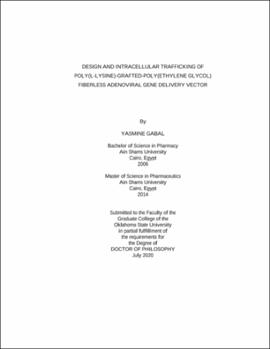| dc.contributor.advisor | Ramsey, Joshua D. | |
| dc.contributor.author | Gabal, Yasmine | |
| dc.date.accessioned | 2021-11-29T21:46:25Z | |
| dc.date.available | 2021-11-29T21:46:25Z | |
| dc.date.issued | 2020-07 | |
| dc.identifier.uri | https://hdl.handle.net/11244/331279 | |
| dc.description.abstract | The first gene therapy clinical trials were started nearly 30 years ago, but the field only now seems to be on the verge of widespread adoption. Safe and efficient gene delivery, however, is still a major obstacle and is often described as "the Achilles' heel of gene therapy." Adenovirus (Ad) is the most common viral vector in gene therapy clinical trial. Adenovirus fiber and capsid proteins, however, mediate an immunogenic response and relies on interaction of the virus with the coxsackie adenovirus receptor (CAR), which limits the ability of the virus to deliver genes into CAR-negative cells such as cancer cells. Our goal was to develop a hybrid vector that overcomes Ad drawbacks as well as understand how our hybrid vector compare to the native virus in intracellular trafficking. A fiberless adenovirus (FlAd) was used with a replacement for the removed fiber protein by poly-L-lysine copolymer grafted polyethylene glycol (PLL-g-PEG). A copolymer library was synthesized using varying molecular weights of PLL and PEG with different degrees of grafting. Hybrid vectors were formed by electrostatically associating PLL-g-PEG with FlAd at different ratios, where "design of experiments" was used to optimize the approach. Hybrid vectors were evaluated by their ability to infect both CAR-positive (HEK 293) and CAR-negative (NIH 3T3) cells. To guide further development of the hybrid vector, we investigated the mechanisms of intracellular trafficking by measuring transduction efficiency and cellular uptake in the presence of a panel of drug inhibitors of various cellular pathways. PLL-g-PEG-FlAd hybrid vectors were able to transduce CAR-positive HEK 293 cells and CAR-negative NIH 3T3 cells with a 3.5- and 10.2-fold increase compared to unmodified FlAd. Addition of the PLL-g-PEG copolymer restored 85% of the infectivity of Ad in HEK 293 cells that was lost as a result of removing the fiber. In addition, hybrid vector was non-cytotoxic on both cell types and showed good serum stability up to 40%. The production of inflammatory cytokines IL-6 and TNFa was also reduced by 70% and 50%, respectively. The removal of the fibers besides the surface modification with PLL-g-PEG copolymer have modified the intracellular trafficking of the hybrid vector to affect the efficiency of the expression of the targeted gene. This stepwise transition from viral to non-viral vectors will lead to novel vectors that are both safe and highly efficient. | |
| dc.format | application/pdf | |
| dc.language | en_US | |
| dc.rights | Copyright is held by the author who has granted the Oklahoma State University Library the non-exclusive right to share this material in its institutional repository. Contact Digital Library Services at lib-dls@okstate.edu or 405-744-9161 for the permission policy on the use, reproduction or distribution of this material. | |
| dc.title | Design and intracellular trafficking of poly(L-lysine)-grafted-poly(ethylene glycol) fiberless adenoviral gene delivery vector | |
| dc.contributor.committeeMember | Gappa-Fahlenkamp, Heather | |
| dc.contributor.committeeMember | Ford Versypt, Ashlee N. | |
| dc.contributor.committeeMember | Ranjan, Ashish | |
| dc.contributor.committeeMember | Ochoa Corona, Francisco | |
| osu.filename | Gabal_okstate_0664D_16857.pdf | |
| osu.accesstype | Open Access | |
| dc.type.genre | Dissertation | |
| dc.type.material | Text | |
| dc.subject.keywords | adenovirus | |
| dc.subject.keywords | cellular trafficking | |
| dc.subject.keywords | fiberless adenovirus | |
| dc.subject.keywords | gene therapy | |
| dc.subject.keywords | hybrid vector | |
| dc.subject.keywords | pll-g-peg | |
| thesis.degree.discipline | Chemical Engineering | |
| thesis.degree.grantor | Oklahoma State University | |
